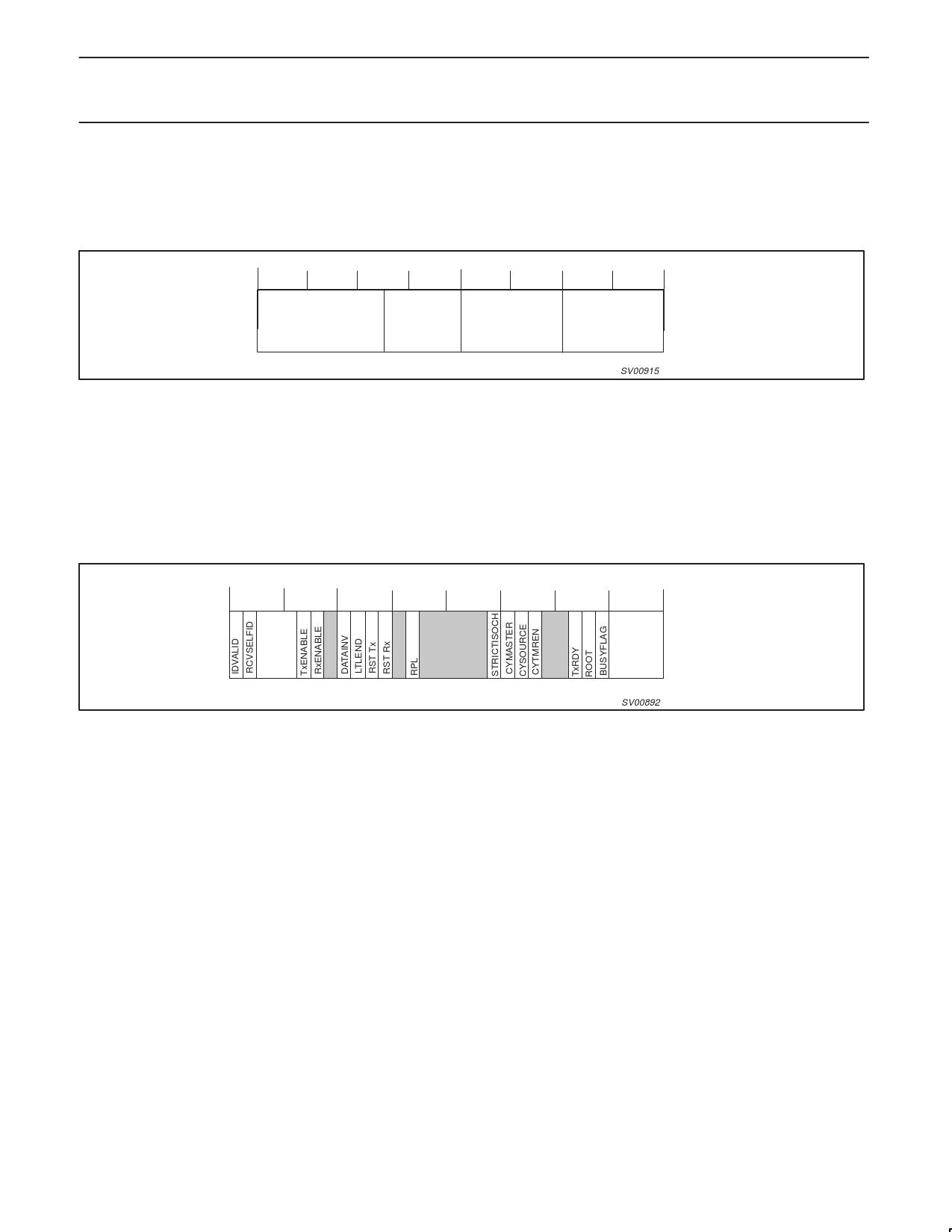PDI1394L21 データシートの表示(PDF) - Philips Electronics
部品番号
コンポーネント説明
一致するリスト
PDI1394L21 Datasheet PDF : 52 Pages
| |||

Philips Semiconductors
1394 full duplex AV link layer controller
Preliminary specification
PDI1394L21
13.1 Link Control Registers
13.1.1 ID Register (IDREG) – Base Address: 0x000
The ID register is automatically updated by the attached PHY with the proper Node ID after completion of the bus reset.
3130 29 28 27 26 25 24 23 22 21 20 19 18 17 16 15 14 13 12 11 10 9 8 7 6 5 4 3 2 1 0
BUS ID
NODE ID
PART CODE
VERSION CODE
SV00915
Reset Value 0xFFFF0101
Bit 31..22:
R/W BUS ID: The 10-bit bus number that is used with the Node ID in the source address for outgoing packets and used to
accept or reject incoming packets. This field reverts to all ‘1’s (0x3FF) upon bus reset.
Bit 21..16:
R/W NODE ID: Used in conjunction with Bus ID in the source address for outgoing packets and used to accept or reject
incoming packets. This register auto-updates with the node ID assigned after the 1394 bus Tree-ID sequence.
Bit 15..8:
R
PART CODE: “01” designates PDI1394L21.
Bit 7..0:
R
VERSION CODE: “02” shows this is revision level 2 of this part.
13.1.2 General Link Control (LNKCTL) – Base Address: 0x004
The General Link control register is used to program the Link Layer isochronous transceiver, as well as the overall link transceiver. It also
provides general link status.
31 30 29 28 27 26 25 24 23 22 21 20 19 18 17 16 15 14 13 12 11 10 9 8 7 6 5 4 3 2 1 0
BSYCTRL
ATACK
SV00892
Reset Value 0x46000002
Bit 31:
R/W IDValid (IDVALID): When equal to one, the PDI1394L21 accepts the packets addressed to this node. This bit is
automatically set after selfID complete and node ID is updated.
Bit 30:
R/W Receive Self ID (RCVSELFID): When asserted, the self-identification packets, generated by each PHY device on the
bus, during bus initialization are received and placed into the asynchronous request queue as a single packet. Bit 30
also enables the reception of PHY configuration packets in the asynchronous request queue.
Bit 29..27:
R/W Busy Control (BSYCTRL): These bits control what busy status the chip returns to incoming packets. The field is
defined below:
000 = use protocol requested by received packet (either dual phase or single phase)
001 = send busy A when it is necessary to send a busy acknowledge (testing/diagnostics)
010 = send a busy B when it is necessary to send a busy acknowledge (testing/diagnostics)
011 = use single phase retry protocol
100 = use protocol requested in packet, always send a busy ack (for all packets)
101 = busy A all incoming packets
110 = busy B all incoming packets are ‘1’
111 = use single phase retry protocol, always send a busy ack
Bit 26:
R/W Transmitter Enable (TxENABLE): When this bit is set, the link layer transmitter will arbitrate and send packets.
Bit 25:
R/W Receiver Enable (RxENABLE): When this bit is set, the link layer receiver will receive and respond to bus packets.
Bit 21:
R/W Reset Transmitter (RSTTx): When set to one, this synchronously resets the transmitter within the link layer.
Bit 20:
R/W Reset Receiver (RSTRx): When set to one, this synchronously resets the receiver within the link layer.
Bit 12:
R/W Strict Isochronous (STRICTISOCH): Used to accept or reject isochronous packets sent outside of specified
isochronous cycles (between a Cycle Start and subaction gap). A ‘1’ rejects packets sent outside the specified
cycles, a “0” accepts isochronous packets sent outside the specified cycle.
Bit 11:
R/W Cycle Master (CYMASTER): When asserted and the PDI1394L21 is attached to the root PHY (ROOT bit = 1), and
the cycle_count field of the cycle timer register increments, the transmitter sends a cycle-start packet. Cycle Master
function will be disabled if a cycle timeout is detected (CYTMOUT bit 5 in LNKPHYINTACK). To restart the Cycle
Master function in such a case, first reset CYMASTER, then set it again.
1999 Aug 06
29